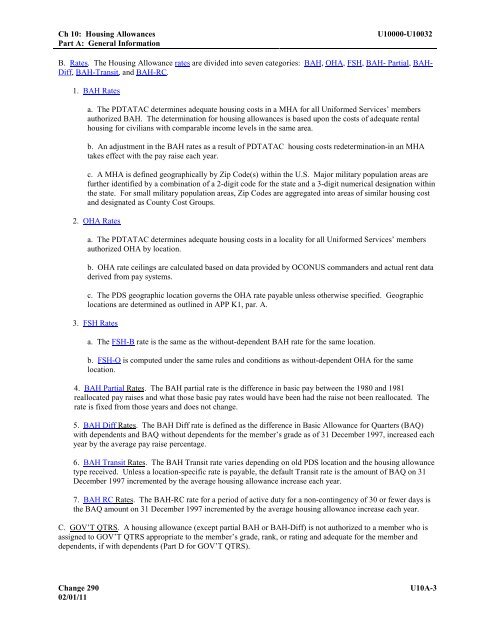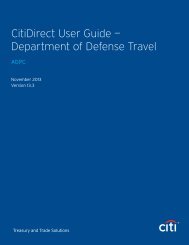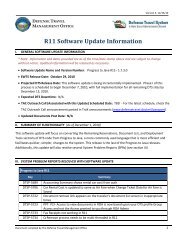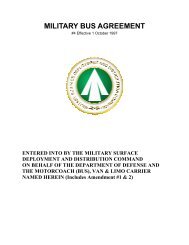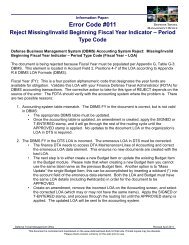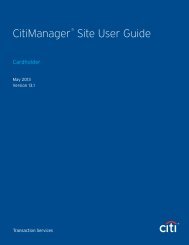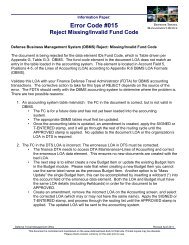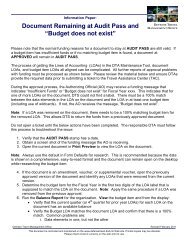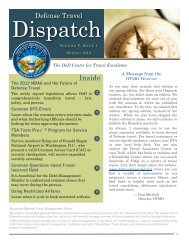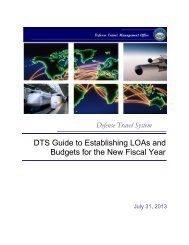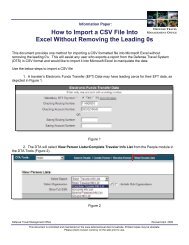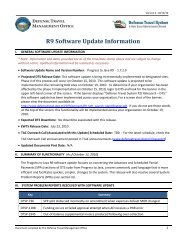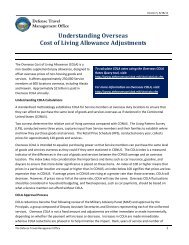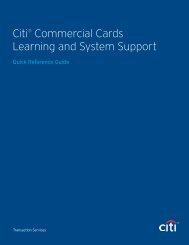JOINT FEDERAL TRAVEL REGULATIONS - DTMO
JOINT FEDERAL TRAVEL REGULATIONS - DTMO
JOINT FEDERAL TRAVEL REGULATIONS - DTMO
You also want an ePaper? Increase the reach of your titles
YUMPU automatically turns print PDFs into web optimized ePapers that Google loves.
Ch 10: Housing Allowances<br />
Part A: General Information<br />
U10000-U10032<br />
B. Rates. The Housing Allowance rates are divided into seven categories: BAH, OHA, FSH, BAH- Partial, BAH-<br />
Diff, BAH-Transit, and BAH-RC.<br />
1. BAH Rates<br />
a. The PDTATAC determines adequate housing costs in a MHA for all Uniformed Services’ members<br />
authorized BAH. The determination for housing allowances is based upon the costs of adequate rental<br />
housing for civilians with comparable income levels in the same area.<br />
b. An adjustment in the BAH rates as a result of PDTATAC housing costs redetermination-in an MHA<br />
takes effect with the pay raise each year.<br />
c. A MHA is defined geographically by Zip Code(s) within the U.S. Major military population areas are<br />
further identified by a combination of a 2-digit code for the state and a 3-digit numerical designation within<br />
the state. For small military population areas, Zip Codes are aggregated into areas of similar housing cost<br />
and designated as County Cost Groups.<br />
2. OHA Rates<br />
a. The PDTATAC determines adequate housing costs in a locality for all Uniformed Services’ members<br />
authorized OHA by location.<br />
b. OHA rate ceilings are calculated based on data provided by OCONUS commanders and actual rent data<br />
derived from pay systems.<br />
c. The PDS geographic location governs the OHA rate payable unless otherwise specified. Geographic<br />
locations are determined as outlined in APP K1, par. A.<br />
3. FSH Rates<br />
a. The FSH-B rate is the same as the without-dependent BAH rate for the same location.<br />
b. FSH-O is computed under the same rules and conditions as without-dependent OHA for the same<br />
location.<br />
4. BAH Partial Rates. The BAH partial rate is the difference in basic pay between the 1980 and 1981<br />
reallocated pay raises and what those basic pay rates would have been had the raise not been reallocated. The<br />
rate is fixed from those years and does not change.<br />
5. BAH Diff Rates. The BAH Diff rate is defined as the difference in Basic Allowance for Quarters (BAQ)<br />
with dependents and BAQ without dependents for the member’s grade as of 31 December 1997, increased each<br />
year by the average pay raise percentage.<br />
6. BAH Transit Rates. The BAH Transit rate varies depending on old PDS location and the housing allowance<br />
type received. Unless a location-specific rate is payable, the default Transit rate is the amount of BAQ on 31<br />
December 1997 incremented by the average housing allowance increase each year.<br />
7. BAH RC Rates. The BAH-RC rate for a period of active duty for a non-contingency of 30 or fewer days is<br />
the BAQ amount on 31 December 1997 incremented by the average housing allowance increase each year.<br />
C. GOV’T QTRS. A housing allowance (except partial BAH or BAH-Diff) is not authorized to a member who is<br />
assigned to GOV’T QTRS appropriate to the member’s grade, rank, or rating and adequate for the member and<br />
dependents, if with dependents (Part D for GOV’T QTRS).<br />
Change 290 U10A-3<br />
02/01/11


